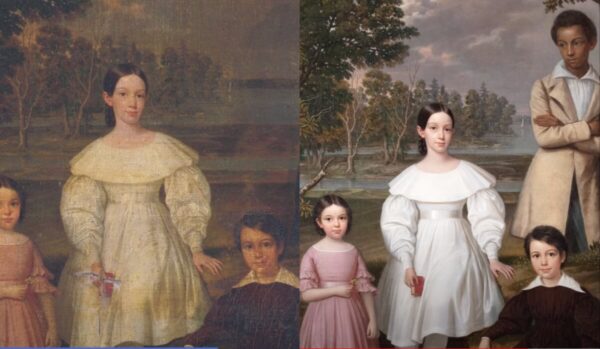The New York Metropolitan Museum of Art has acquired a newly restored piece of history: a portrait of three white children and their enslaved caretaker.
Now, people can see the Louisiana treasure the former owner says was too important to be in a private collection.

The portrait is now called Bélizaire and the Frey Children and was commissioned in 1837 by Frederick Frey, a German-born family man living in Louisiana.
According to the Met, the painting “represents one of the rarest and most fully documented American portraits of a Black individual depicted with the family of his White enslaver.”
Frey, the enslaver, had hoped to have a painting featuring his three children, Elizabeth, Léontine and Frederick Jr.
The merchant and banker also allowed his 15-year-old servant to be featured in the painting with his children.
Jacques Guillaume Lucien Amans, a French neoclassical painter, was hired for the job. He positioned the two daughters and the son in the front, leaving the Afro-Creole teenager, identified as Bélizaire, in the shadows leaning up against a tree. However, up until a few years ago, the enslaved domestic was all but erased from history.
At some point, possibly during Jim Crow, according to some experts, the portrait was painted over.
However, in the 1970s, the true representation of the piece of art would be restored.
During this time, Audrey Grasser, who is the great-great-granddaughter of Coralie Frey, Frederick’s wife, generously gifted the portrait to the New Orleans Museum of Art; the picture had a subtle suggestion that there initially might have been a fourth subject. Grasser told NOMA she believed this additional figure represented an enslaved child that her ancestors owned.
Still, the museum never investigated any deeper into Grasser’s suggestion.
In 2005, the piece was sold in an auction for $7,200, and the new owner had the painting restored; the Black teen was exposed from the layered paint.
Sixteen years later, another buyer, Jeremy K. Simien, would emerge with a grander vision for the work, restoring it for the second time.
He collaborated with Louisiana historian Katy Morlas Shannon, who examined property and census records and meticulously identified all individuals present in the portrait, including Bélizaire, whom she estimated was born around 1822 and was purchased by the family, along with his mother, when he was six.
“The fact that he was covered up haunted me,” Simien said.
“The aura was too great to be in a private collection. I had a duty to place it somewhere … where it wouldn’t be forgotten again,” Simien said in an interview with The Times-Picayune/The New Orleans Advocate.
After linking with the Met, it was determined to be the first naturalistic portrait of a named Black subject set in a Southern landscape in the museum’s collection. While it represents a stretch in diversifying the museum’s art acquisition, specifically as it approaches its 100th-year anniversary, the distinctive work also gives a revealing look at “the complex relationships of intimacy and trauma that slavery bred.”
Now a part of the Met’s Gallery 756 of the American Wing, it will be on display this fall.


